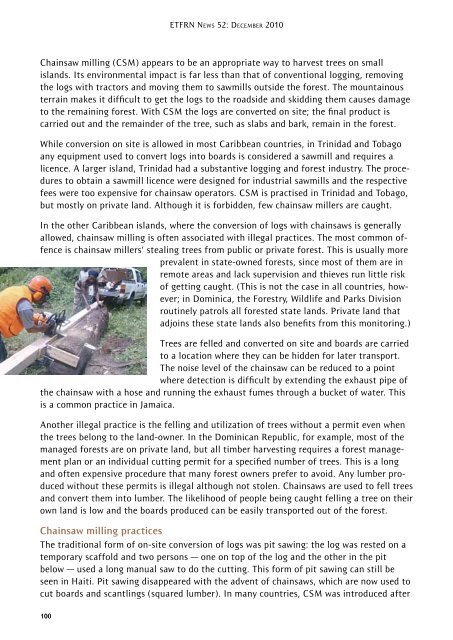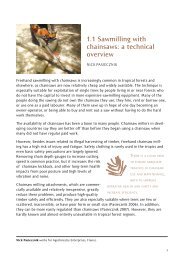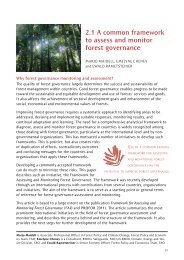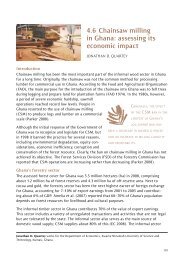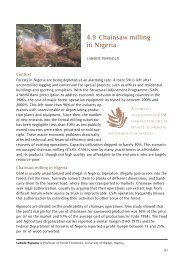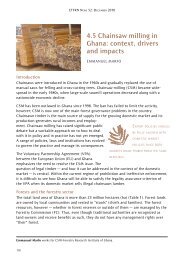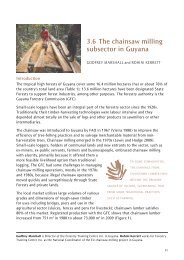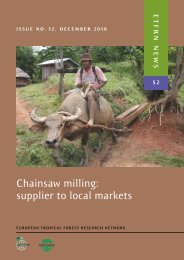Chainsaw milling: supplier to local markets - European Tropical ...
Chainsaw milling: supplier to local markets - European Tropical ...
Chainsaw milling: supplier to local markets - European Tropical ...
You also want an ePaper? Increase the reach of your titles
YUMPU automatically turns print PDFs into web optimized ePapers that Google loves.
100<br />
ETFRN NEws 52: DEcEmbER 2010<br />
<strong>Chainsaw</strong> <strong>milling</strong> (Csm) appears <strong>to</strong> be an appropriate way <strong>to</strong> harvest trees on small<br />
islands. its environmental impact is far less than that of conventional logging, removing<br />
the logs with trac<strong>to</strong>rs and moving them <strong>to</strong> sawmills outside the forest. The mountainous<br />
terrain makes it difficult <strong>to</strong> get the logs <strong>to</strong> the roadside and skidding them causes damage<br />
<strong>to</strong> the remaining forest. with Csm the logs are converted on site; the final product is<br />
carried out and the remainder of the tree, such as slabs and bark, remain in the forest.<br />
while conversion on site is allowed in most Caribbean countries, in Trinidad and Tobago<br />
any equipment used <strong>to</strong> convert logs in<strong>to</strong> boards is considered a sawmill and requires a<br />
licence. a larger island, Trinidad had a substantive logging and forest industry. The procedures<br />
<strong>to</strong> obtain a sawmill licence were designed for industrial sawmills and the respective<br />
fees were <strong>to</strong>o expensive for chainsaw opera<strong>to</strong>rs. Csm is practised in Trinidad and Tobago,<br />
but mostly on private land. although it is forbidden, few chainsaw millers are caught.<br />
in the other Caribbean islands, where the conversion of logs with chainsaws is generally<br />
allowed, chainsaw <strong>milling</strong> is often associated with illegal practices. The most common offence<br />
is chainsaw millers’ stealing trees from public or private forest. This is usually more<br />
prevalent in state-owned forests, since most of them are in<br />
remote areas and lack supervision and thieves run little risk<br />
of getting caught. (This is not the case in all countries, however;<br />
in Dominica, the Forestry, wildlife and parks Division<br />
routinely patrols all forested state lands. private land that<br />
adjoins these state lands also benefits from this moni<strong>to</strong>ring.)<br />
Trees are felled and converted on site and boards are carried<br />
<strong>to</strong> a location where they can be hidden for later transport.<br />
The noise level of the chainsaw can be reduced <strong>to</strong> a point<br />
where detection is difficult by extending the exhaust pipe of<br />
the chainsaw with a hose and running the exhaust fumes through a bucket of water. This<br />
is a common practice in Jamaica.<br />
another illegal practice is the felling and utilization of trees without a permit even when<br />
the trees belong <strong>to</strong> the land-owner. in the Dominican republic, for example, most of the<br />
managed forests are on private land, but all timber harvesting requires a forest management<br />
plan or an individual cutting permit for a specified number of trees. This is a long<br />
and often expensive procedure that many forest owners prefer <strong>to</strong> avoid. any lumber produced<br />
without these permits is illegal although not s<strong>to</strong>len. <strong>Chainsaw</strong>s are used <strong>to</strong> fell trees<br />
and convert them in<strong>to</strong> lumber. The likelihood of people being caught felling a tree on their<br />
own land is low and the boards produced can be easily transported out of the forest.<br />
chainsaw <strong>milling</strong> practices<br />
The traditional form of on-site conversion of logs was pit sawing: the log was rested on a<br />
temporary scaffold and two persons — one on <strong>to</strong>p of the log and the other in the pit<br />
below — used a long manual saw <strong>to</strong> do the cutting. This form of pit sawing can still be<br />
seen in haiti. pit sawing disappeared with the advent of chainsaws, which are now used <strong>to</strong><br />
cut boards and scantlings (squared lumber). in many countries, Csm was introduced after


